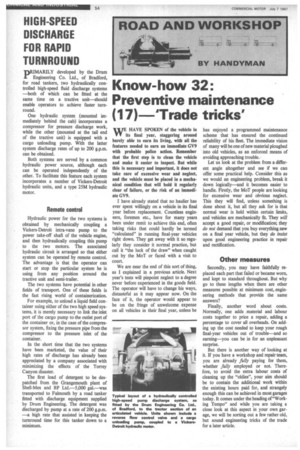Know-how 32: Preventive maintenance (17) 'Trade tricks'
Page 56

If you've noticed an error in this article please click here to report it so we can fix it.
WEHAVE SPOKEN of the vehicle in its final year, staggering around barely able to earn its living, with all the features needed to earn an immediate GV9 with probable police action. Remember that the first step is to clean the vehicle and make it easier to inspect. But while this is necessary and Important, it does not take care of excessive wear and neglect, and the vehicle must be placed in a mechanical condition that will hold it regularly clear of failure, or the risk of an immediate GV9.
I have already stated that no haulier has ever spent willingly on a vehicle in its final year before replacement. Countless engineers, foremen etc., have for many years been under remit to achieve this end, often taking risks that could hardly be termed "calculated" in running final-year vehicles right down. They get away with it so regularly they consider it normal practice, but call it "the luck of the draw" when caught out by the MoT or faced with a visit to court.
We are near the end of this sort of thing, as I explained in a previous article. Next year's tests will pinpoint neglect to a degree never before experienced in the goods field. The operator will have to change his ways, distasteful as it may appear now. On the face of it, the operator would appear to be on the fringe of unwelcome expense on all vehicles in their final year, unless he has enjoyed a programmed maintenance scheme that has ensured the continued reliability of his fleet. The immediate vision of many will be one of new material ploughed into old vehicles, as an enforced means of avoiding approaching trouble., Let us look at the problem from a different angle altogether and see if we can offer some practical help. Consider this as we would an engineering problem, break it down logically—and it becomes easier to handle. Firstly, the MoT people are looking for excessive wear and obvious neglect. This they will find, unless something is done about it, but all they ask for is that normal wear is held within certain limits, and vehicles are mechanically fit. They will accept a good repair, or modification; they do not demand that you buy everything new on a final year vehicle, but they do insist upon good engineering practice in repair and rectification.
Other measures
Secondly, you may have faithfully replaced each part that failed or became worn, and kept to standard throughout. But why go to these lengths when there are other measures possible at minimum cost, engineering methods that provide the same answers?
Finally, another word about costs. Normally, one adds material and labour costs together to price a repair, adding a percentage to cover all overheads. On adding up the cost needed to keep your rough final-year vehicles out of trouble—and so earning—you can be in for an unpleasant surprise.
But there is another way of looking at it. If you have a workshop and repair team, you are already fully paying for them, whether fully employed or not. Therefore, to avoid the extra labour costs of cleaning up the "oldies", your aim should be to contain the additional work within the existing hours paid for, and strangely enough this can be achieved in most garages today. It comes under the heading of "Working Tempo" and while you are taking a close look at this aspect in your own garage, we will be sorting out a few rather old, but sound engineering tricks of the trade for a later article.




































































































































